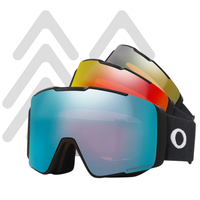Everything you need to know about ski goggles: Complete guide
When planning a mountain outing, ski goggles are an essential piece of equipment. They protect you from UV rays, wind, and snow, while improving your vision in various weather conditions. To help you make the right choice, we've prepared this guide detailing the different lens types, goggle sizes, materials, and quick-change systems.

1. The different types of ski lenses
Lens Categories and Their Use
Ski lenses are mainly distinguished by their tint and their Visible Light Transmission (VLT). Here’s a summary table of the categories and their uses:
80% to 100% → Night or low light conditions
40% to 80% → Low to moderate light, improved contrast
20% to 50% → Variable conditions, ideal for partly sunny days
5% to 20% → Very sunny days, maximum UV protection
Tip: Photochromic lenses automatically adjust their VLT according to light conditions, providing a versatile solution.
2. Choose the right size of glasses
Small, Medium, or Large Faces
Ski goggles should fit comfortably on your face and be compatible with your helmet. Sizes are generally divided into three main categories:
Small size: Ideal for children or adults with narrow faces.
Medium size: Suitable for the majority of skiers.
Large size: Perfect for wide faces or for those looking for an expanded field of vision.

3. Spherical and cylindrical lenses
The choice between spherical and cylindrical lenses is an important factor when buying ski goggles. These two types of lenses differ in shape and visual performance.
Spherical Lenses
Shape:
Cylindracal Lens
Curved both horizontally and vertically.
Field of view:
Wider with better peripheral vision.
Distortion reduction:
Optimal reduction of optical distortions.
Anti-fog:
Better ventilation thanks to increased curvature.
Price:
Generally higher due to advanced design
Cylindrical Lenses
Shape:
Curved only horizontally.
Field of view:
Slightly narrower, but sufficient for most skiers.
Distortion reduction:
May cause slight distortion, especially at the edges.
Anti-fog:
Less effective ventilation in some cases.
Price:
More affordable, ideal for a limited budget.
Conclusion
The choice of ski goggles depends on your specific needs and the weather conditions you encounter. Whether you're looking for photochromic lenses, a quick-change system, or durable materials, our store offers a diverse range to meet all your expectations.
-Store Team
